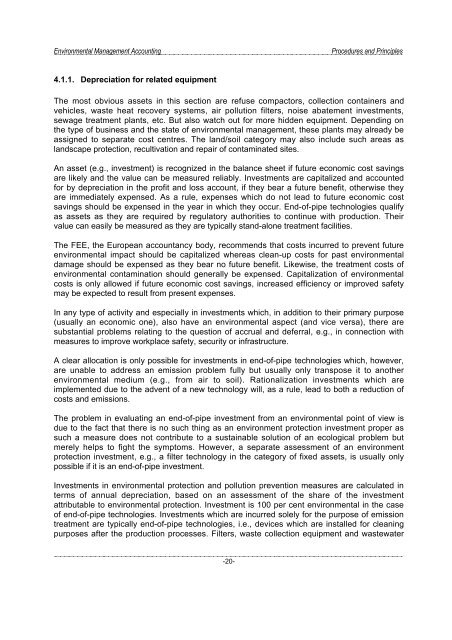Environmental Management Accounting Procedures and Principles
Environmental Management Accounting Procedures and Principles
Environmental Management Accounting Procedures and Principles
Create successful ePaper yourself
Turn your PDF publications into a flip-book with our unique Google optimized e-Paper software.
<strong>Environmental</strong> <strong>Management</strong> <strong>Accounting</strong><br />
<strong>Procedures</strong> <strong>and</strong> <strong>Principles</strong><br />
4.1.1. Depreciation for related equipment<br />
The most obvious assets in this section are refuse compactors, collection containers <strong>and</strong><br />
vehicles, waste heat recovery systems, air pollution filters, noise abatement investments,<br />
sewage treatment plants, etc. But also watch out for more hidden equipment. Depending on<br />
the type of business <strong>and</strong> the state of environmental management, these plants may already be<br />
assigned to separate cost centres. The l<strong>and</strong>/soil category may also include such areas as<br />
l<strong>and</strong>scape protection, recultivation <strong>and</strong> repair of contaminated sites.<br />
An asset (e.g., investment) is recognized in the balance sheet if future economic cost savings<br />
are likely <strong>and</strong> the value can be measured reliably. Investments are capitalized <strong>and</strong> accounted<br />
for by depreciation in the profit <strong>and</strong> loss account, if they bear a future benefit, otherwise they<br />
are immediately expensed. As a rule, expenses which do not lead to future economic cost<br />
savings should be expensed in the year in which they occur. End-of-pipe technologies qualify<br />
as assets as they are required by regulatory authorities to continue with production. Their<br />
value can easily be measured as they are typically st<strong>and</strong>-alone treatment facilities.<br />
The FEE, the European accountancy body, recommends that costs incurred to prevent future<br />
environmental impact should be capitalized whereas clean-up costs for past environmental<br />
damage should be expensed as they bear no future benefit. Likewise, the treatment costs of<br />
environmental contamination should generally be expensed. Capitalization of environmental<br />
costs is only allowed if future economic cost savings, increased efficiency or improved safety<br />
may be expected to result from present expenses.<br />
In any type of activity <strong>and</strong> especially in investments which, in addition to their primary purpose<br />
(usually an economic one), also have an environmental aspect (<strong>and</strong> vice versa), there are<br />
substantial problems relating to the question of accrual <strong>and</strong> deferral, e.g., in connection with<br />
measures to improve workplace safety, security or infrastructure.<br />
A clear allocation is only possible for investments in end-of-pipe technologies which, however,<br />
are unable to address an emission problem fully but usually only transpose it to another<br />
environmental medium (e.g., from air to soil). Rationalization investments which are<br />
implemented due to the advent of a new technology will, as a rule, lead to both a reduction of<br />
costs <strong>and</strong> emissions.<br />
The problem in evaluating an end-of-pipe investment from an environmental point of view is<br />
due to the fact that there is no such thing as an environment protection investment proper as<br />
such a measure does not contribute to a sustainable solution of an ecological problem but<br />
merely helps to fight the symptoms. However, a separate assessment of an environment<br />
protection investment, e.g., a filter technology in the category of fixed assets, is usually only<br />
possible if it is an end-of-pipe investment.<br />
Investments in environmental protection <strong>and</strong> pollution prevention measures are calculated in<br />
terms of annual depreciation, based on an assessment of the share of the investment<br />
attributable to environmental protection. Investment is 100 per cent environmental in the case<br />
of end-of-pipe technologies. Investments which are incurred solely for the purpose of emission<br />
treatment are typically end-of-pipe technologies, i.e., devices which are installed for cleaning<br />
purposes after the production processes. Filters, waste collection equipment <strong>and</strong> wastewater<br />
-20-




